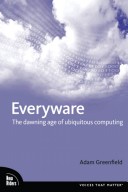
I’m starting to review texts for the computers and writing course I hope to teach in the fall (RHE 312), and I recently reread Adam Greenfield’s Everyware: The Dawning Age of Ubiquitous Computing (2006). The primary innovation of Greenfield’s book is, rather than there being just one model of ubiquitous or pervasive computing (ubicomp) there are in fact many “ubiquitous computings,” and that these ubicomps will combine to form an all-encompassing paradigm of distributed computing, communication, networking, and information gathering/retrieval which he calls “everyware.”
One unique feature of this book is Greenfield’s reaction to ubiquitous technology. It seems like the typical reaction to new technology (see genetic modification and nanotechnology) is to question the ethics of using/adopting it and to call for a halt to this use/adoption so its long-term effects can be contemplated. Greenfield, however, simply declares that everyware is inevitable, and that our best efforts will be spent in working toward altering its eventual appearance, rather than trying to prevent it.
In Section 3, “What’s driving the emergence of everyware?”, Greenfield examines the reasons for this inevitability. His argument is essentially twofold: first, he claism that at the moment our technology became digital, and devices were able to communicate with each other in a common language of ones and zeros, that the communication and interoperability on which everyware depends was a foregone conclusion. Further, Greenfield argues that the architecture and capabilities of many current technologies—RFID tags, the continuing development of computer chips, wireless computing—all contain the latent possibility of everyware. As he puts it, a technology like RFID “wants” to be connected to everything so as to provide a bridge between atoms and bits. Second, he argues that everyware is inevitable because it is both embedded in our collective imaginations in the form of science fiction and a workable solution to many of our looming problems, such as dealing with the move of the baby-boom generation into old age and the need of corporations for ever-increasing economic expansion.
Another thing I liked about the book is that Greenfield captures the complexity and contradictions inherent in ubiquitous systems. Everyware is divided into seven sections, and each section is made up of “theses” introduced by short, declarative statements (“Thesis 05: At its most refined, everyware can be understood as information processing dissolving into behavior.”), which are then explained, expanded on, or defended over the course of a few pages. While the sections gather the theses into larger arguments, I think they allow Greenfield to not force an extreme level of coherence on a topic whose edges are still coming into view.
To me, the two most interesting sections of the book are the first two (Google Books has the complete TOC). In these sections, Greenfield defines everyware and explains how it is unique from other instantiations of computing. As I noted above, he argues that everyware is not the same as ubicomp, but is rather a paradigm which contains many ubicomps. According to Greenfield, the everyware paradigm is the interconnection of various technologies and processes so that the computing experience will no longer be centered on a desktop or laptop machine, but will be a continuous experience of information retrieval (and encoding) via technology embedded in our surroundings. As part of this process, the bridging of the divide between data and the lived world will be key to the development of everyware.
One of his most striking pronouncements is that everyware will transform behavior into information, or, as he puts it, everyware represents the “colonization of everyday life by information technology.” Greenfield recognizes the emergent qualities of the combination of ubiquitous computing and society. Everyware is different from regular computing in that it is centered on the user and the environment. It is contextual and experiential, rather than a group of tasks like information retrieval. It does not have users—although it might have subjects. It is relational, and, as such, it has the possibility of yoking together a number of technologies and systems that we are already familiar with so that they become greater than the sum of their parts. Further, these connections will result in outcomes and effects that will be completely unforeseen.
In the book’s second section, Greenfield describes how everyware is unique. According to Greenfield, the combination of ubiquitous technologies on which everyware is based, fostered by digital connections and their inherent relational structures, will lead to emergent outcomes. That is, it will not be possible to completely foresee the results of this technology interacting together, and this fact virtually guarantees that the result will be unique. (Which would make pausing the development of the technologies everyware depends on so we can contemplate their use virtually pointless.)
Conclusion: Everyware is a good, non-technical introduction to the issues affecting the development of ubiquitous computing. I think it would be a good text for introducing undergrads to the opportunities and problems associated with new, distributed computing models.
Wednesday, January 16, 2008
Review: Adam Greenfield, Everyware: The Dawning Age of Ubiquitous Computing (2006)
Subscribe to:
Post Comments (Atom)
No comments:
Post a Comment